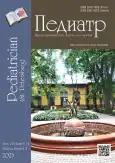The experience of medical support for the evacuation of the civilian population, children and adolescents across the Road of Life in 1941–1942
- Authors: Arsentev V.G.1, Tsymbal A.A.1,2, Shabalov N.P.1, Tsymbal A.N.3,4, Kalyadin S.B.1, Pakhomova M.A.5
-
Affiliations:
- Kirov Military Medical Academy
- K.A. Rauhfus St. Petersburg Children’s Municipal Multi-Specialty Clinical Center of High Medical Technology
- North-Western State Medical University named after I.I. Mechnikov
- 442nd Military Clinical Hospital
- Saint Petersburg State Pediatric Medical University
- Issue: Vol 14, No 2 (2023)
- Pages: 137-145
- Section: History of medicine
- URL: https://journals.eco-vector.com/pediatr/article/view/530534
- DOI: https://doi.org/10.17816/PED142137-145
- ID: 530534
Cite item
Abstract
The organization of medical support during the evacuation of the population, including children and adolescents during the Great Patriotic War, especially in 1941–1942, is unique. Attention is drawn to the scale — the timing of the organization of evacuation, the number of evacuated people, methods — by water, aviation, land transport. Special attention in conditions of shortage deserves catering — all evacuees received a hot lunch and rations for the road in the form 1 kg of bread. Gradually, the prevention of infectious diseases was established, vaccination against dysentery was actively used, teams of epidemiologists and disinfection and washing teams were formed, medical support was provided. In total, from the beginning of the blockade to the end of 1942, about 1 million 100 thousand people were evacuated, of which 871 thousand Leningraders. And during the war, about 1 million 738 thousand people were taken out of Leningrad in an organized manner, of which 1 million 360 thousand Leningraders. Priority in mass evacuation was given to children and adolescents — the future of the country. All the sick and wounded, whose treatment required more than 45 days, were subject to evacuation. Thanks to the precise organization of care for evacuees on the way and during the period of overload from one mode of transport to another, difficulties were transferred to the wounded and sick relatively easily. Thanks to the planned work during the evacuation, mass outbreaks of infectious diseases were prevented by medical workers, mortality was reduced as much as possible and the possibility of restoring normal nutrition and life in the evacuation areas was ensured.
Full Text
About the authors
Vadim G. Arsentev
Kirov Military Medical Academy
Author for correspondence.
Email: rainman63@mail.ru
MD, PhD, Dr. Sci. (Med.), Head of the Department of Children's Diseases
Russian Federation, Saint PetersburgAnastasia A. Tsymbal
Kirov Military Medical Academy; K.A. Rauhfus St. Petersburg Children’s Municipal Multi-Specialty Clinical Center of High Medical Technology
Email: tsymbal.anastasi@gmail.com
SPIN-code: 7484-2225
Head of the Reception Department; Postgraduate Student
Russian Federation, Saint Petersburg; Saint PetersburgNikolai P. Shabalov
Kirov Military Medical Academy
Email: rainman63@mail.ru
MD, PhD, Dr. Sci. (Med.), Professor of the Department of Childhood Illness
Russian Federation, Saint PetersburgAleksandr N. Tsymbal
North-Western State Medical University named after I.I. Mechnikov; 442nd Military Clinical Hospital
Email: ats421@mail.ru
MD, PhD, Associate Professor of the Department of Mobilization Training of Healthcare and Disaster Medicine; Head of the Сonsultative and Diagnostic Polyclinic
Russian Federation, Saint Petersburg; Saint PetersburgSergey B. Kalyadin
Kirov Military Medical Academy
Email: s.kaliadin@yandex.ru
SPIN-code: 5549-0964
MD, PhD, Associate Professor, Department of Children's Diseases
Russian Federation, Saint PetersburgMariya A. Pakhomova
Saint Petersburg State Pediatric Medical University
Email: scrcenter@mail.ru
SPIN-code: 3168-2170
Senior Researcher, Research Center
Russian Federation, Saint PetersburgReferences
- Arkhiv shtaba Leningradskogo voennogo okruga. F. 47, op. 16860. Istoricheskaya spravka shtaba okruga. (In Russ.)
- Basov AV. Flot v Velikoi Otechestvennoi voine 1941–1945. Moscow: Nauka, 1980. 304 p. (In Russ.)
- Gladkikh PF. Zdravookhranenie blokadnogo Leningrada: 1941–1944 gg. 2nd edition. Leningrad: Meditsina, 1985. 268 p. (In Russ.)
- Knopov MSh, Taranukha VK. The medical service of Leningrad front during the Leningrad blockade. Problems of social hygiene, public health and history of medicine, Russian journal. 2012;(1):61–63. (In Russ.)
- Ivanov DO, Mikirchichan GL, Savina IA, et al. Objekt 708: podvig leningradskikh pediatrov. Saint Petersburg: SPBGPMU, 2021. 176 p. (In Russ.)
- Ignat’ev PV, Korshunov EhL, Rupasov AI. Leningrad. Voina. Blokada. Snyatie osady: materialy i issledovaniya. Saint Petersburg: GALART, 2019. 528 p. (In Russ.)
- Ignat’ev PV, Korshunov EhL, Rupasov AI. Leningrad. Voina. Blokada. Pobednye zalpy: materialy i issledovaniya. Saint Petersburg: GALART, 2020. 608 p. (In Russ.)
- Ovsyanikov YuV. Podvig rechnikov na Doroge zhizni. Saint Petersburg: Kolo, 2021. 208 p. (In Russ.)
- Sokolov VA, Tsvetkov DS. The contribution of domestic scientists to the development of approaches to the evacuation of the wounded by air transport in the 1930s. Russian military medical journal. 2021;342(3):86–91. (In Russ.) doi: 10.17816/RMMJ82603
- Tarasov OF, Shabalov NP. Aleksandr Fedorovich Tur (1894–1974). Moscow: Meditsina, 1980. 126 p. (In Russ.)
- Tsentral’nyi Gosudarstvennyi arkhiv Sankt-Peterburga. F. 7384, op. 3, d. 50 l. 189–193. (In Russ.)
- Shabalov NP, Erman lV. Pediatrics healthcare during the siege of Leningrad. Children’s Medicine of the North-West. 2010;1(1):78–80. (In Russ.)
Supplementary files











